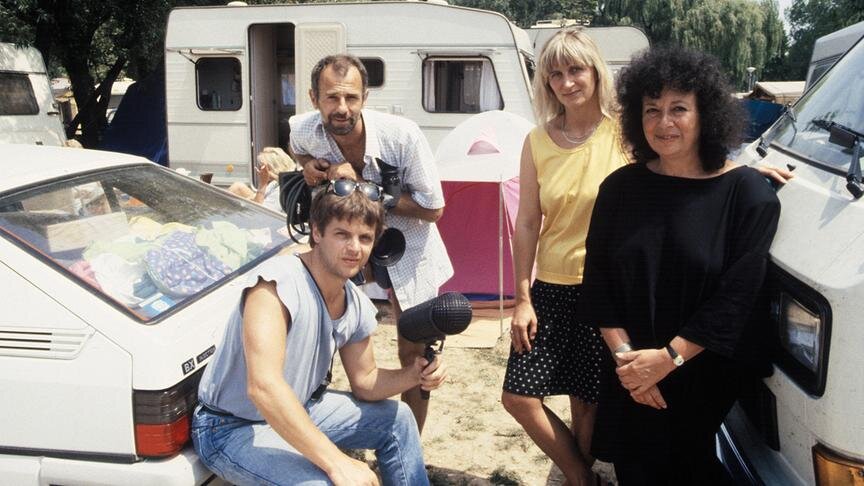Alltagsgeschichte: If all time is eternally present
Lara Moran
Elizabeth T. Spira had a perfect voice. In her documentary series Alltagsgeschichte you can hear her (offscreen, always) interviewing people in a tone that is gentle, but insistent – slightly mocking, but kind in a way that makes you think you might still impress her by telling her even more than you already have. It’s the voice that counsellors should have, but never do, and Spira knew how to exploit this quality in her work as a journalist.
Elizabeth T Spira (right) with crew on the set of Alltagsgeschichte
Image credit: ORF: Milenko Badzic
Alltagsgeschichte began airing on Austria’s public broadcasting channel ORF in the mid-1980s. Each episode documents a different area in Vienna by interviewing the people who frequent it. Sometimes these locations are specific, as in an episode that covers the Prater amusement park, but more often they are conceptual: The Bus Stop, The Coffee Shop, The Public Pool. Spira created the format in collaboration with historian Michael Mitterauer and their goal was to record the ‘ordinary people’ of Vienna. The phrase often associated with the programme is kleine Leute, a popular euphemism for the working class that literally translates to ‘small people’. To an English ear this might sound condescending or even pejorative, but its connotations are more ambiguous than that; it has the same implication of respectability you might associate with a ‘small business owner’ and is therefore often employed by politicians with populist leanings, but I have yet to hear someone describe themselves with the term.
The more banal the chosen theme of the episode, the better. Alltagsgeschichte seems to me like the last sputter of the same cultural turn that gave birth to the Mass Observation Project in Britain – a modernist enthusiasm for new documentary possibilities and a conviction that these must be applied to the facets of life that constitute the everyday (Alltag).
Image Credit: ORF: Cosmos Factory: Peter Kasperak
The show’s last episode was produced in 2006, but reruns still draw large audiences. Alltagsgeschichte unfolds with the drowsy slowness you associate with August heat and, fittingly, old episodes are a staple of the ORF’s late-night summer programming. In one of my favourite episodes, In einer kleinen Konditorei (‘In a small patisserie’) Spira talks to an old woman who takes a toy guardian angel everywhere she goes and sits it in the empty ashtray as she eats her cake; a couple who have been married for more than fifty years, their matching frail figures hunched over slices of Apfelstrudel; and at least three customers who speak at length about their diabetes, the camera closing in on their plates as they dutifully scrape the icing from their mille-feuille. It’s riveting.
You might call what the show does ‘people-watching’, an activity that in recent years has become a charming signifier of sorts – a quirky hobby adopted by people keen on proving that they have an interest in others, while at the same time performatively displaying that interest to bolster their own identity as someone who is good, someone who cares. It’s easy to be cynical about because, like many acts of observation, people-watching is a form of solipsism that can easily be mistaken for empathy. I have sat across from many strange and beautiful people on the underground and in waiting rooms, and while I would like to think that the attention I paid them bears any significance to anyone but myself, the truth is that I never actually got up to talk to them. Spira knows how to pick up at this delicate moment in which connection would be possible, if only people followed through with their professed desire to understand others better.
Image Credit: ORF: Cosmos Factory: Peter Kasperak
Alltagsgeschichte offers people the chance to talk about their concerns and the things they care about, but it knows better than to indulge in clichés like ‘so, what’s your story?’ Instead Spira follows a relaxed line of questioning that leads wherever the interviewee takes it – recollections of childhood, ramblings on the meaning of life, occasionally a xenophobic rant. The interview locations provide a frame for each episode that roots the conversations in a particular present context. It brings to mind the oft-quoted lines from Eliot’s Four Quartets – ‘Time present and time past / Are both perhaps present in time future, / And time future contained in time past.’ Old episodes, which set out to document the post-war atmosphere that still lingered in Vienna, have become historical artefacts in themselves; to watch them feels like moving through the labyrinthine layers of a collective Austrian psyche.
Image Credit: ORF
Spira’s tone rarely wavers and I used to think the series was a spectacular feat of neutrality. Re-watching it today, I am reminded of what I didn’t know as a child: that all television cares about is your attention and that no gaze is ever neutral. I watch reruns of Alltagsgeschichte on nights when it is too hot to sleep and find myself laughing at the half-crazed speeches of the interviewees. Sometimes the camera lingers on them after they stop talking and I stop laughing. In her movie Lady Bird (2017) Greta Gerwig postulates that perhaps they are ‘the same thing – love and attention,’ but I’m very sceptical of that claim. Is it enough simply to listen to people? Am I really empathising with the people on-screen, am I any closer to understanding them, or is the attention of a camera always an othering influence? Sitting in the blue glow of the television, it’s easy to think that all you need to do is ask more questions than you answer.



